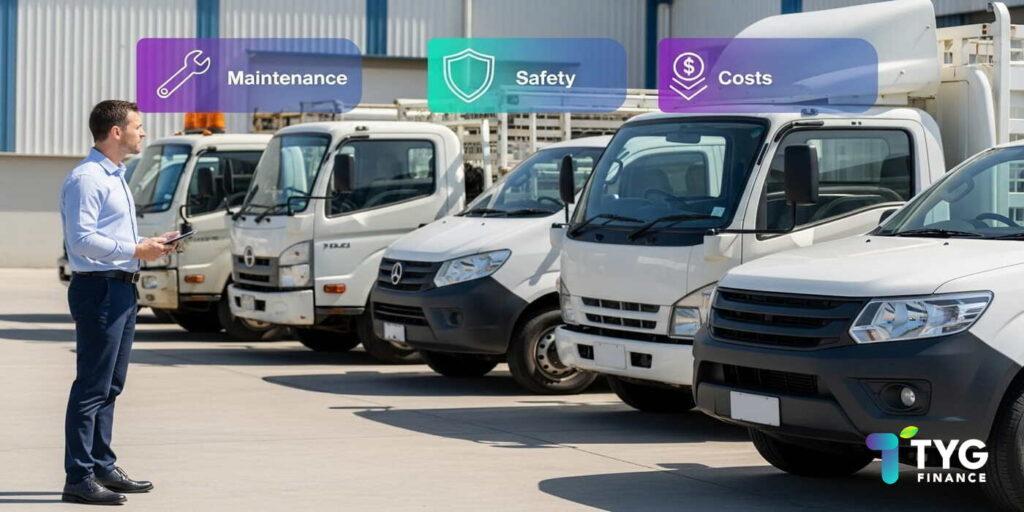A Challenge Many Operators Recognise
In the logistics sector, vehicles are not just tools of the trade — they are the backbone of business. For one mid-sized logistics company operating across regional and metropolitan routes in Australia, the strain of an aging fleet was becoming increasingly difficult to ignore.
Maintenance costs were climbing, downtime was eating into delivery schedules, and insurance premiums reflected the rising risk profile of older vehicles. At the same time, the business was under pressure to demonstrate its commitment to driver safety, particularly as industry standards and customer expectations evolved.
This is the story of how the operator explored options for managing costs and improving safety, and how TYG Finance provided support along the way.
The Problem: Balancing Ageing Assets and Safety Commitments
The company’s fleet was largely made up of utes and vans purchased over a decade ago. While these vehicles had served reliably, several challenges were mounting:
- Escalating repairs: Annual maintenance costs had doubled in the past five years – a common outcome when a preventative maintenance schedule is no longer effective for aging assets.
- Increased downtime: Unexpected breakdowns meant missed deliveries and frustrated clients.
- Insurance implications: Older vehicles without modern safety technology were raising premiums.
- Safety concerns: Management recognised that driver fatigue and accident risk were compounded by the lack of advanced safety features.
The operator faced a tough question: should they continue patching up the fleet or consider replacement strategies that might offer better cost control and safer outcomes?
The Exploration: Considering Fleet Management Options
The leadership team began evaluating different approaches, weighing both financial and operational impacts. Some of the considerations included:
1. Extending the Fleet’s Life
At first, the company explored whether they could stretch the fleet’s lifespan with further repairs and part replacements. While cheaper in the short term, it became clear that long-term costs could outweigh the benefit, as mechanical issues were becoming more frequent and harder to predict.
2. Replacing Select Vehicles
Rather than an all-at-once replacement, management considered gradually upgrading vehicles, starting with those in the poorest condition. The focus was on critical assets — particularly high-use utes and vans that endured the toughest duty cycles.
Ute Finance and Van Finance options provided tailored pathways to spread the cost of upgrades. These tailored pathways for specific asset classes, including those needed for seasonal agricultural work, are key to effective financing.
3. Enhancing Driver Safety Programs
In parallel, the company reviewed driver safety initiatives, recognising that technology and training are key pillars of modern fleet efficiency. They considered investing in training programs, telematics, and other monitoring systems to help reduce accident risk. These measures, while not a substitute for modern vehicles with built-in safety technology, could complement fleet upgrades.
The Role of TYG Finance
At this stage, the company engaged TYG Finance to explore how financing solutions could support their goals without straining cash flow.
Rather than focusing solely on interest rates or repayment terms, the conversation centered on:
- Aligning repayments with seasonal cash flow variations common in logistics – a crucial tactic for any business looking to manage its finances effectively.
- Exploring pre-approval facilities to allow fast decision-making when vehicles became available.
- Structuring finance in a way that allowed the business to stagger fleet replacement over several years.
This strategic approach gave the company flexibility — the ability to act when opportunities arose, without overcommitting upfront capital.
Potential Solutions Explored
With guidance from TYG Finance, the operator outlined several potential pathways:
- Staggered Replacement Program
- Replace 20% of the fleet annually.
- Focus on high-mileage vans first, then transition to the utes.
- Leverage trade-in value while resale opportunities remained viable.
- Financing Safety-Focused Upgrades
- Prioritise newer vehicles equipped with driver assistance systems (lane departure warnings, fatigue detection, collision avoidance).
- Pair financing with safety training to reinforce ROI.
- Data-Driven Fleet Management
- Use telematics to track maintenance needs and driver behaviour.
- Monitor TCO (total cost of ownership) over time to fine-tune replacement timing.
Each pathway had trade-offs, but collectively, they pointed to a smarter, staged approach rather than a single costly overhaul.
Possible Outcomes Considered
While the company is still progressing through its fleet optimisation journey, several potential outcomes were identified:
- Reduced Maintenance Costs: Replacing the most problematic vehicles could help stabilise annual repair expenses.
- Improved Driver Morale: Employees expressed stronger confidence in driving newer, safer vehicles.
- Lower Insurance Premiums: By upgrading vehicles with modern safety features, the company anticipated more favourable insurance terms.
- Enhanced Reputation: Clients increasingly view safety and reliability as critical; a refreshed fleet could strengthen competitive positioning.
Why This Matters Beyond One Operator
The challenges faced by this logistics business are common across asset-heavy industries, where balancing fleet costs with driver safety is a central and not-so-obvious part of strategic fleet management.
Industry bodies such as the Australian Road Safety Foundation and the Australasian Fleet Management Association (AfMA) consistently highlight that investment in safety pays off over the long term. However, many businesses require flexible financial solutions to make these investments feasible.
Key Learnings from This Journey
- Fleet replacement doesn’t have to be all or nothing — staged approaches can balance cost and safety.
- Financing can be structured strategically to align with operational realities.
- Driver safety programs may complement fleet upgrades, delivering ROI in reduced risk and downtime.
- Proactive planning, not reactive repairs, tends to create more predictable financial outcomes.
A Smarter Way Forward
For this logistics operator, the journey toward optimising fleet costs and enhancing driver safety has been about exploring options, testing assumptions, and finding the right balance between operational needs and financial strategy.
While the path is still unfolding, one thing is clear: the combination of practical fleet planning and tailored finance solutions can give businesses the tools they need to stay competitive and safe.
Get Pre-Approved Today with TYG Finance and explore how your fleet strategy could align with your financial goals.


